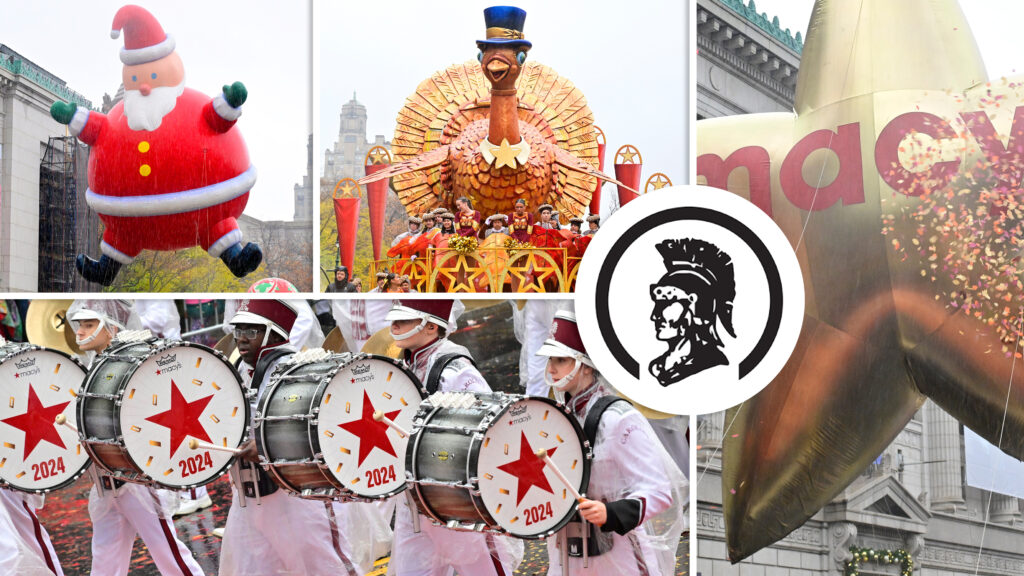Jeffry Mason is a special friend of mine. In 1977, he was my partner in the mallet line of the Cavaliers, back when only two mallet players were allowed in a corps and we had to carry the instruments around our necks. After not seeing him for a multitude of years, we got together in Allentown, Pa., last year and spent much time together during the days of and after the show. When he later mentioned the memory jogging caused by the interstate highway trip to Allentown, I asked him to write about it.
Before I begin, I should let you know I marched for nine years in junior corps and three in senior, but had never set foot on the field or seen a show in Allentown, Pa. With all of the hype over the Cavaliers (of which I am a proud alumnus) being undefeated in a season and a half and the Blue Devils tearing up everything in their path, I thought, “This is the year.” What resulted was a nice three-day vacation away from work (the closing days of an audit) and the city of Toronto. I saw two nights of phenomenal performances, visited some of the sights in the Lehigh Valley and spent some time with Mike Boo. Mike and I marched together in the Cavalier mallet line his age-out year and have kept in touch ever since. The last time we met face-to-face was at the 1995 DCI Finals in Buffalo, N.Y., but that was only a brief “encounter” as he was involved “backstage” writing about the production. Something happened on the trip down that I hadn’t anticipated. From 1972 through 1975, I marched with a Canadian corps (the Scarborough Firefighters who became the Scarborough Princemen who became the Seneca Princemen who merged with the Toronto Optimists to become the Seneca Optimists) which competed on what I believe was called the New York-Pennsylvania circuit. Driving through New York state became a virtual “trip down memory lane” for me as it seemed that every exit bore the name of the city of a corps I had competed beside. Crossing the border at Lewiston, I got on the 219 and headed south. Immediately, a sign to Lockport, home of the Blazers, greeted me. Further south as we approached Buffalo, there were signs to North Tonawanda. Not only was this the home of the Coachmen, but it was also home to the North Tonawanda Open. I have mixed memories of this show in 1973 and 1974 … but that’s an entirely different story. Anyone from the 1974 Auburn Black Watch out there? Back to the trip. Around this same time, I drove past a sign to Lackawana, home of the Melodiers. I turned east on to I-90. The first sign that caught my eye was for Batavia. I never saw St. Joseph’s when they were a competitive junior corps, but they were on the B-side of the second drum corps recording I ever owned (1970 North American Open, volume 1). As a short aside, I bought Volume 2 first (Cavaliers, Optimists, Anaheim Kingsmen and the Hudson C.Y.O. Band). St. Joe’s came back in 1995 as an alumni corps, and I have been entertained by the sounds of the ’60s and early ’70s on a number of occasions over the ensuing years. Further down the I-90 was a cutoff for 390 South. This is where it started to hit me — “Where have they all gone?” If I had gone down that road, and did so on many occasions in the early ’70s, I would have found the homes of the American Patrol (Geneseo … I think they had another name, but I can’t remember it), Mark Twain Cadets (Elmira), the Barons of Steuben (Corning) and the Squires (Watkins Glen). When we competed in the Squires’ home show, they housed us. When they came to our show, we returned the favor. Man, that was a good corps and they knew how to have fun! I know this is a drum corps forum, but Canandaigua is on that route too. Remember the fabulous winter guard from the academy? Back to the I-90. A little further east was Rochester! Home to the Greece Cadets, Mighty Liberators and Alpine Girls, an all-girl unit (actually from Irondequoit). This was also the sight of the 1973 VFW State contest. Seneca won the show but could not claim the title as we were from out of state. I think either the Marauders or the Magnificent Yankees took the flag home. Next was an exit for Geneva, home of the Appleknockers. I once heard that they were either the first, or one of the first corps to carry contra bass horns. Their heyday may have been in the ’60s, but their annual contest was always a “who’s who” of drum corps. I was lucky enough to compete there in 1973. By the time I got to I-81, where I had to turn south, my head was spinning with all of these memories. If I had gone north at this junction, I would have come to Fulton, home of the Gauchos and Owego, home of the Black Knights as well as the all-girl Mello-Dears. If I had continued east, I would have come to Rome, home of the Cavaliers; Utica, home of the Magnificent Yankees; and Troy, home of the Speigelaires. As it was, I turned south and passed through Syracuse. Other than memories of a WGI World Championships in 1981, where the Cavaliers Winter Guard won the first of their three consecutive titles, and the 2000 DCA Championships, where as a member of the Kingston Grenadiers, I came in eighth place; this was home to the Marauders, the Eagles (Verona) and Tri-Town Cadets (Castille). Further south was an exit for DCI’s only Division I finalist from New York State, the Auburn Purple Lancers. I only competed against them once, but just the sight of those uniforms gave me an incredible feeling. Next up, Ithaca. That was actually the sight where the Purple Lancers ended up in DCI World Finals. Wow … that was 30 years ago! Binghamton. I’m pretty sure I was there in 1974. I can’t remember all of the corps in attendance, but two stand out in my memory: These were the Keystone Regiment, who went on to become the Crossmen, and the Belvederes of Schuylkill. I had no idea where Schuylkill was until later that day when I toured an old coal mine in Ashland, Pennsylvania. Neither of these were from New York State, but they did leave a lasting impression on me. If I had turned west from Binghamton, I would have come to Endicott, home of the Southern Tier Grenadiers. They were another strong corps that stands out in my memory. If I had turned east, I would have come to Poughkeepsie, home of a contest called the Pow Wow. I never saw the Indians, but they were a senior corps from that town and I’m trying to limit myself to the junior ranks. 1973 was a year I will never forget. This show had the Muchachos, St. Andrew’s Bridgemen, St. Rita’s Brassmen (from the Bronx, New York), CMCC Warriors (from New York City), Blue Rock, the Falcon Cadets (who may still have been going by the name Polish Falcons) and my corps, Seneca. There may have been an eighth corps, but my memory fails me. That contest was amazing. Just being on the same field with some of those legendary corps was such a thrill. This was the first and last time I saw St. Rita’s. What a great corps they had that year. If I had continued further down the highway I would have reached Brooklyn, home of the OLPH Ridgemen and eventually found myself in Hicksville. The perennial all girl champions St. Ignatius hailed from there. It was also the last time I saw Blue Rock and CMCC. This was also the first and only time I saw St. Andrew’s in their old Cadet-style uniforms. That’s another story too! I have mentioned a number of corps I may have seen only once or twice. Several of these were very competitive at one time or another, and others were small local corps. I know I have probably left out several organizations and apologize for any I may have missed. What struck me on this trip was that even though New York was a “hotbed” of junior corps activity when I marched, all of these corps are now gone. I mourn their loss, but remember them all with fondness. I sincerely hope that readers who marched with some of these corps will have the same feeling. Drum corps has changed in so many ways over the years since that very first DCI World Championship in 1972. There has been a tremendous growth in musicianship, the entertainment value has attained levels none of us could have foreseen thirty years ago and it has become a very polished competitive activity. I praise all of those involved with putting this product on the field year in and year out. Please … let us never forget our roots and never forgot the individuals and corps we stood with on retreat. Jeffry J. Mason
Precious Blood Cardinals 1970-1971
Seneca Princemen 1972-1975
Toronto Optimists 1976
Park Ridge Cavaliers 1977-1978
Kingston Grenadiers 1995-1996, 2000
Michael Boo has been involved with drum and bugle corps since 1975, when he marched his first of three seasons with the Cavaliers.
He has a bachelor’s degree in music education and a master’s degree in music theory and composition.
He has written about the drum corps activity for over a quarter century for publications such as Drum Corps World, and presently is involved in a variety of projects for Drum Corps International, including souvenir program books, CD liner notes, DCI Update and Web articles, and other endeavors. Michael currently writes music for a variety of idioms, is a church handbell and vocal choir director, an assistant director of a community band, and a licensed Realtor in the state of Indiana. His other writing projects are for numerous publications, and he has published an honors-winning book on the history of figure skating. His hobbies include TaeKwonDo and hiking the Indiana Dunes. But more than anything, Michael is proud to love drum corps and to be a part of the activity in some small way, chronicling various facets of each season for the enjoyment of others.





